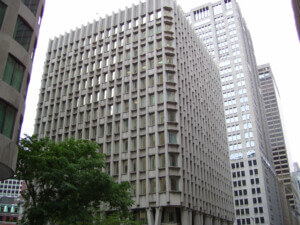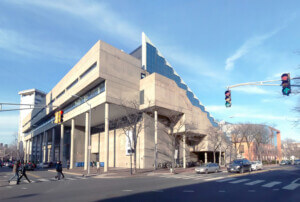With 901 (and counting) documented buildings, #SOSBrutalism may be the most comprehensive database of béton brut online. Being just a collection of concrete (and more) though isn’t the website’s primary focus. Instead, #SOSBrutalism aims to shed light on endangered Brutalist buildings throughout the world, acting as a springboard for potential campaigns to save what it calls “our beloved concrete monsters.”
In doing so, buildings are indexed through a variety of categories including, date, location, typology, and search tags. The most important category is “status,” which lists buildings as either “saved,” “endangered,” “partially saved,” “partially demolished,” “least concerned,” and “demolished.” The database is open and can be added to by anyone who emails in (you can so do here), provided images and a description are supplied.
#SOSBrutalism can also be used as an educational device of sorts, as it guides users through the realms of style and the criteria it uses to define “Brutalism.” Citing renowned architecture critic Reyner Banham, who described Brutalist heroes Alison and Peter Smithson’s Hunstanton School (and their unrealized Soho House) as “points of architectural reference by which the New Brutalism in architecture may be defined,” named its three key elements: “1, Memorability as an image; 2, Clear exhibition of structure; and 3, Valuation of materials as found.”
Buildings that were included in Banham’s “The New Brutalism: Ethic or Aesthetic?” have subsequently be labeled with the hashtag #Banham1966. Others built before 1955 have also been tagged #Forerunner meanwhile, aside from Banham’s criteria for the style, #SOSBrutalism has prescribed its own: “Brutalist buildings are not always made of concrete. But they are always “rhetorical” in that they blatantly place the focus on their material or sculptural form,” it explains.
While some buildings, such as Robin Hood Gardens in East London—also by the Smithsons—and Marcel Breuer’s Atlanta Central Library seem destined for demolition, the growing number of “saved” structures featured is encouraging. That said, Brutalism in Britain may be particularly challenging to save, especially given Prime Minister David Cameron’s distaste for Brutalist “sink estates.”
“Step outside in the worst estates, and you’re confronted by concrete slabs dropped from on high, brutal high-rise towers, and dark alleyways that are a gift to criminals and drug dealers, he said at the start of the year. “The police often talk about the importance of designing out crime, but these estates actually designed it in.”
Despite the troubles facing some of the buildings, #SOSBrutalism is set to lead an exhibition on the style in Frankfurt next year, collaborating with the Deutsches Architekturmuseum (DAM) and the Wüstenrot Stiftung.










